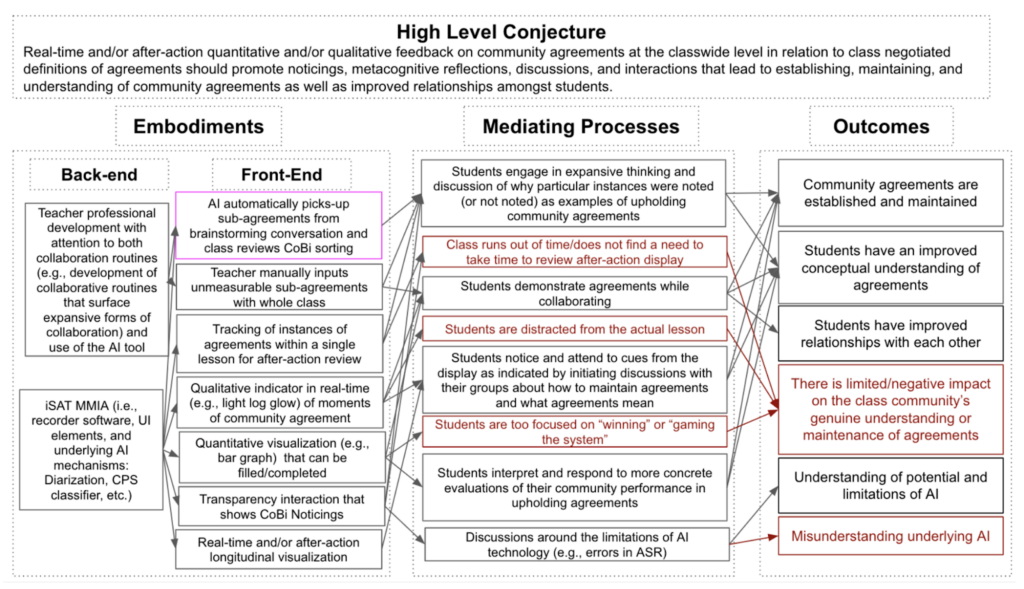Conjecture Mapping
by Michael Alan Chang
Key Ideas
Conjecture maps can help research partners from different disciplines find a shared language for identifying common goals and expectations. Conjecture maps can help youth and researchers collaboratively illustrate hopes and dreams in an actionable format.
Background
Recent work in the learning sciences (Gutierrez & Jurow, 2018; Garcia & Mirra, 2023) and technology (Dunne & Raby, 2013; Dombrowski et al., 2016; Wong & Khovanskaya, 2018) recognizes the transformative and political nature of our collective work, which involves making a powerful call to the community to surface joyful, expansive, equitable futures imagined by non-dominant communities. Yet we do not dream for the sake of dreaming; we dream to understand how this work meaningfully shapes our research and design work in the present. In considering the role of emergent technology in this mission, it’s difficult to imagine computer science alone in bringing about the necessary institutional change that movement towards expansive equitable futures often requires. If the community of computer scientists and learning scientists work together toward constructing these expansive futures, deep collaboration between the computing and learning sciences is absolutely critical. Our work as a partnership shows that conjecture maps (Sandoval, 2013l) can serve as a meaningful first step toward engaging computer scientists and learning scientists in the making of imagined futures (Chang et al., 2022c).
Conjecture Maps to Support Partnerships
Conjecture maps are a tool from the learning sciences that support the design-based research approach. Using conjecture maps, researchers establish theory-supported connections between tangible learning designs and desired learning outcomes. Recent work extends conjecture maps so that computer scientists can meaningfully participate in creation of the tangible learning designs, starting from the insight that many technical decisions made by learning scientists do not fit within the bounds of the learning sciences (Chang et al., 2022b). A key affordance of conjecture maps is that they allow computer scientists and learning scientists to draw connections between technical components and more traditional learning interventions. By explicitly highlighting the necessary learning interventions, designers additionally make transparent the essential institutional change that must occur for the technology design to make the expected impact.
Conjecture maps have played a central role in work in the interdisciplinary NSF National Institute for Student-AI Teaming (iSAT) (Chang et al., 2022a). Our Learning Futures Workshop (Chang et al., 2022) surfaced the hopes and dreams of youth of color about ideal collaboration with peers and educators in and out of school, and the role of artificial intelligence in making those dreams a reality. In our workshop space, youth rejected an AI approach that policed their behavior, and instead proposed a Community Builder. The Community Builder would support youth in collectively creating community collaborative norms and holds them accountable to these norms. Rather than simply building out the technology, researchers in iSAT used a conjecture map to interrogate how to create the necessary classroom conditions to realize the youth’s complete vision. We show the completed conjecture map in Figure 1. Conversations held by computer scientists and learning scientists over the conjecture map supported a major realization; because youth-driven community agreements deviated from well-established practices in the schools we are partnering with, learning scientists would have to develop specific community building routines (Reiser et al., 2021) and train teachers in professional development settings in order for the Community Builder to be used in the way that youth dreamed about.
We are still early in our journey, but we have seen how conjecture maps are one powerful tool that supports an interdisciplinary team of researchers in identifying necessary institutional changes and technical developments to help make those dreams a reality. To learn more about how to work across interdisciplinary teams to build conjecture maps, please reference our conjecture mapping primer, which can be found here.

